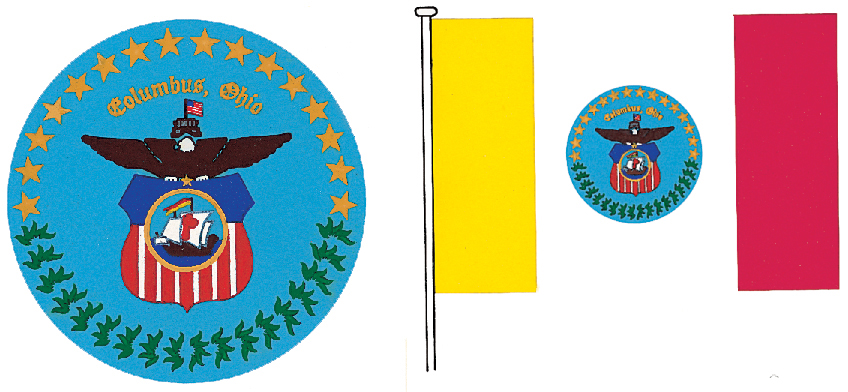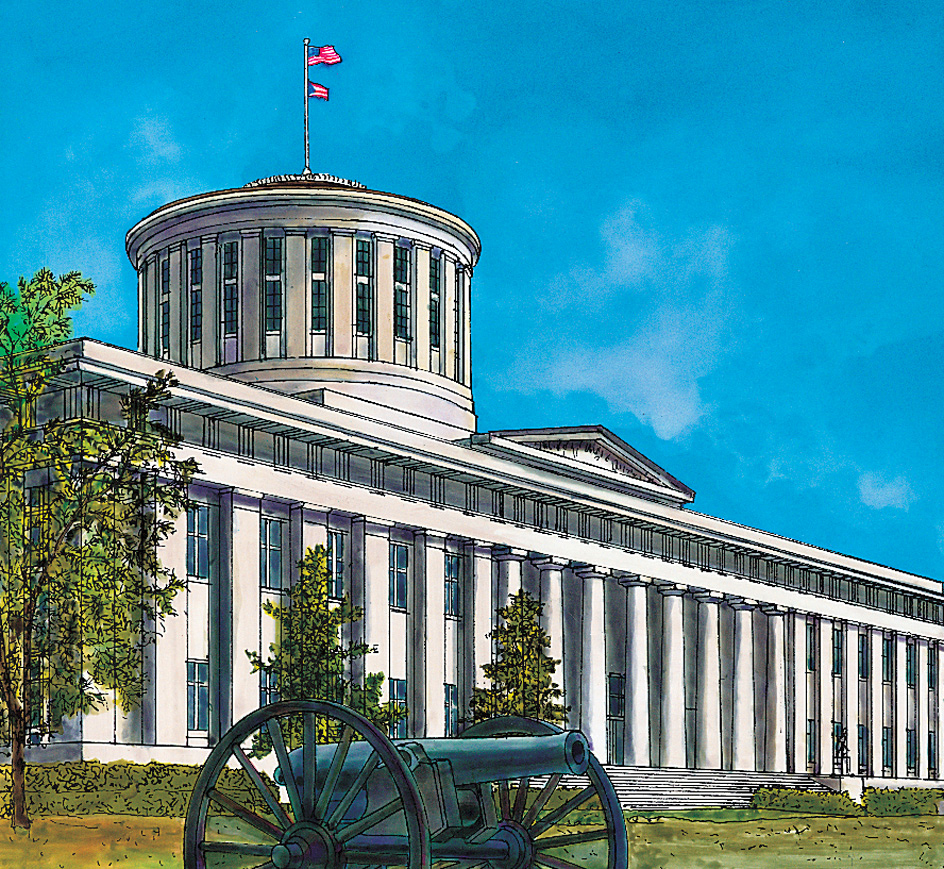Columbus, Ohio, is the capital and largest city of the state. It is a leading research, information technology, and retail center. Columbus lies near the center of Ohio, where the Olentangy and Scioto rivers meet. The city is the home of the main campus of Ohio State University, one of the nation’s largest universities.
Almost all of Ohio lies within 150 miles (241 kilometers) of Columbus. In 1812, the state legislature chose the site for the capital because it could be reached easily from all major Ohio cities. Many state leaders wanted to name it Ohio City. But General Joseph Foos, a legislator from Franklin County, suggested Columbus to honor the explorer Christopher Columbus.
The city
is the seat of Franklin County. Columbus has about 25 suburbs. The Columbus metropolitan area includes Delaware, Fairfield, Franklin, Hocking, Licking, Madison, Morrow, Perry, Pickaway, and Union counties. 
The limestone State Capitol stands in Capitol Square, a 10-acre (4-hectare) park at the intersection of the city’s main avenues, High and Broad streets.
Columbus’s tallest building, the Rhodes State Office Tower, rises 629 feet (192 meters) on the east shore of the Scioto River. Other east shore structures include federal and state office buildings, City Hall, police headquarters, and LeVeque Tower, which houses the Palace Theatre. A bronze statue of Christopher Columbus stands 20 feet (6 meters) high in City Hall Plaza. The city received the statue from the citizens of Genoa, Italy, the explorer’s birthplace.
The Ohio state fairgrounds and Ohio State University are on the north side of Columbus. German Village, a restored German settlement of the mid-1800’s, covers 233 acres (94 hectares) just south of downtown.

People.
Non-Hispanic white people make up about half of Columbus’s population. This group consists mainly of people of English, German, and Irish descent. African Americans make up about 30 percent of the population. Columbus also has a growing population of people of Asian ancestry. 
Church groups, such as the Columbus Metropolitan Area Church Council, have helped the city fight against racial problems, juvenile delinquency, and poverty. Hundreds of Christian congregations are represented in the council. Many non-Christian congregations also work with the group. Another group, Impact Community Action, helps manage federal, city, and state welfare programs.
In 1960, Columbus became the nation’s first city to build apartment projects for senior citizens that included special recreational facilities. The city also maintains other recreation centers for elderly citizens.
Economy.
Retail and wholesale trade establishments employ many Columbus-area workers. Other leading employers include government agencies, manufacturing firms, insurance companies, and health care providers. Columbus is headquarters for several companies that provide information services. CAS (Chemical Abstracts Service), a division of the American Chemical Society, is a leading source of information about chemistry. The OCLC (Online Computer Library Center), in nearby Dublin, provides information services for libraries and other institutions.
Research firms located in the city include the Battelle Memorial Institute, which conducts scientific research for private industry and the government (see Battelle Memorial Institute). The institute operates one of the largest private research laboratories in the world.
Manufacturers in Columbus produce airplanes and automobile parts, cement mixers, coal-mining equipment, electric appliances, and foundry and machine shop materials. Other industries in the city include printing and publishing. Columbus has one daily newspaper, The Columbus Dispatch.
Railroads and truck lines provide freight service to the city. Airlines use John Glenn Columbus International Airport (formerly Port Columbus International Airport) and Rickenbacker International Airport.
Education.
Columbus pioneered education. In 1837, the city began the nation’s first state-operated school for the blind. The first junior high school in the United States opened in Columbus in 1909. And in 1922, Ohio State University founded radio station WOSU, the first educational radio station in North America.
A seven-member elected Board of Education supervises the Columbus City Schools. In addition, education is provided at dozens of private and church-supported schools in the city. The Columbus Board of Education has made special efforts to involve the community in its work. The board sponsors radio and television shows, holds neighborhood meetings, and publishes reports on the city’s schools and their students and staff.
Ohio State University is the largest university in Ohio. Other institutions of higher learning in Columbus include Capital University, Columbus College of Art & Design, Franklin University, Mount Carmel College of Nursing, Ohio Dominican University, and Pontifical College Josephinum, the only seminary in the Western Hemisphere that is directly subject to the Vatican. Several other seminaries, colleges, and business schools are also in the Columbus metropolitan area. The Columbus Metropolitan Library has a main library and several branch libraries.
Cultural life and recreation.
The Columbus Symphony Orchestra, Opera Columbus, and the city’s ballet company perform at the Ohio Theatre. Broadway touring shows are presented at the Palace Theatre.
The Columbus Museum of Art has an outdoor sculpture park and garden featuring American and European sculpture of the 1800’s and 1900’s. The exhibit presents the works of such artists as Alexander Calder, Aristide Maillol, and Henry Moore. The city’s Center of Science and Industry includes a planetarium. The Ohio History Center has exhibits of Indian life in early Ohio.
The Columbus Arts Festival, held each June on the downtown riverfront, features displays of architecture and painting, and performances of dance and drama. The state fair is held annually in late July and early August. It includes agricultural exhibits and entertainment, and provides a showplace for Ohio artists.
Columbus has many parks and playgrounds. The Scioto Mile includes a pedestrian promenade, performance spaces, and other park features downtown along the Scioto River. The Scioto Greenways trails link parklands throughout the area. The Columbus Park of Roses displays thousands of rose plants. The Columbus Zoo and Aquarium features baby farm animals that youngsters may feed and pet. The zoo is known for its ape collection. The first gorilla born in captivity was born in the zoo in 1956. The city is home to the Columbus Blue Jackets of the National Hockey League and Columbus Crew SC of Major League Soccer.
Government.
Columbus has a mayor-council form of government. The voters elect the mayor and seven council members to four-year terms. A city income tax provides Columbus with over half its revenue.
During the 1960’s, the lack of good public transportation became an important problem in the Columbus area. The governments of Franklin County and Columbus and nearby cities jointly established the Central Ohio Transit Authority in 1971 to deal with this problem. The agency purchased Columbus’s privately owned bus company.
History.
The Delaware and Wyandot Indians lived in what is now the Columbus area before white settlers first arrived. In 1797, settlers founded Franklinton, the first city in the area, on the west side of the Scioto River. The Ohio legislature established Columbus on the east bank, opposite Franklinton, in 1812. Within a year, Columbus had about 300 people. They included many Germans, and Germans continued to settle on the south side of the city throughout the 1800’s. In 1816, the Ohio legislature moved to Columbus from Chillicothe, the temporary state capital. By that year, the city’s population had grown to about 700.

During the 1830’s, Columbus developed as a transportation and trade center. In 1831, a canal connecting Columbus with the Ohio and Erie Canal opened the way to increased trade with Eastern cities. The National Road, one of the principal pioneer routes to the West, reached Columbus in 1833. The city had about 3,500 people when it was incorporated in 1834.
The arrival of the railroad in the middle 1800’s brought more commerce to Columbus. When the American Civil War began in 1861, the city had a population of 18,629. During the war, Columbus became the assembly point for Ohio troops and the site of the largest Northern prison for Confederate soldiers. In 1871, Columbus extended its boundaries and annexed most of Franklinton across the river. By 1900, the city’s population had grown to 125,500, and buggy manufacturing had made Columbus the industrial leader of central Ohio.
In 1913, nearly 100 people died when the Scioto River flooded Columbus. After this flood, the greatest disaster in the city’s history, Columbus began a waterfront renewal project. The city built flood walls, bridges, and the beginning of the civic center.
Columbus continued growing during the 1900’s. The city’s population jumped from 290,500 in 1930 to about 565,000 in 1980. Maynard E. Sensenbrenner, who served as mayor of Columbus during most of the 1950’s, 1960’s, and early 1970’s, developed a policy of annexing an average of 6 1/2 square miles (17 square kilometers) of unincorporated land around the city each year.
During the 1950’s, new suburban shopping centers, restaurants, and theaters began to take business away from downtown Columbus. The city worked to bring people back to the downtown area. Renewal projects during the 1960’s included rebuilding or replacing several old downtown buildings and rebuilding German Village, which had been in poor condition since the early 1900’s. New construction included a number of office buildings, high-rise apartment buildings, motels, and an underground parking garage. Two refurbished downtown theaters opened in the 1970’s. A 41-story state office building was completed in 1975.
New construction in the downtown area in the 1980’s included a convention center. The convention center was enlarged in the 1990’s and became the Greater Columbus Convention Center. Also in the 1990’s, new shopping and entertainment establishments opened on the northern rim of the city.
In the late 1990’s and early 2000’s, entertainment districts developed on the edges of the downtown area, in the Brewery District, which lies south of downtown and west of German Village, and the Arena District, north of downtown. Such businesses as restaurants and nightclubs opened in areas that were once dominated by warehouses, railroad yards, and light manufacturing firms. These developments spurred interest in downtown living.
The 2020 U.S. census listed Columbus as Ohio’s largest city. According to the census, the city had a population of about 905,000.
